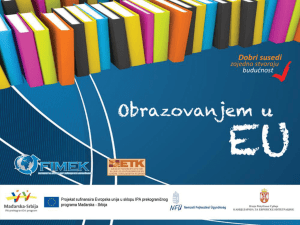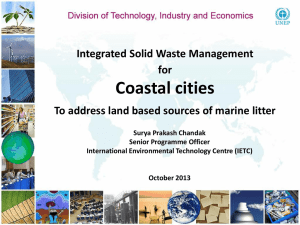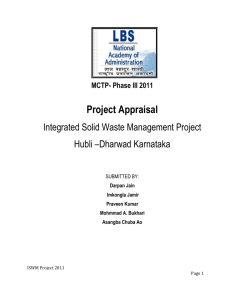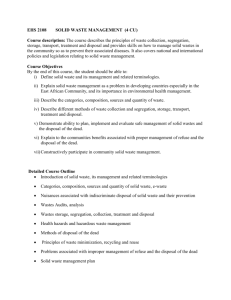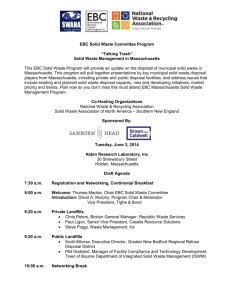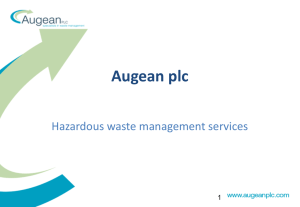doc - UNEP
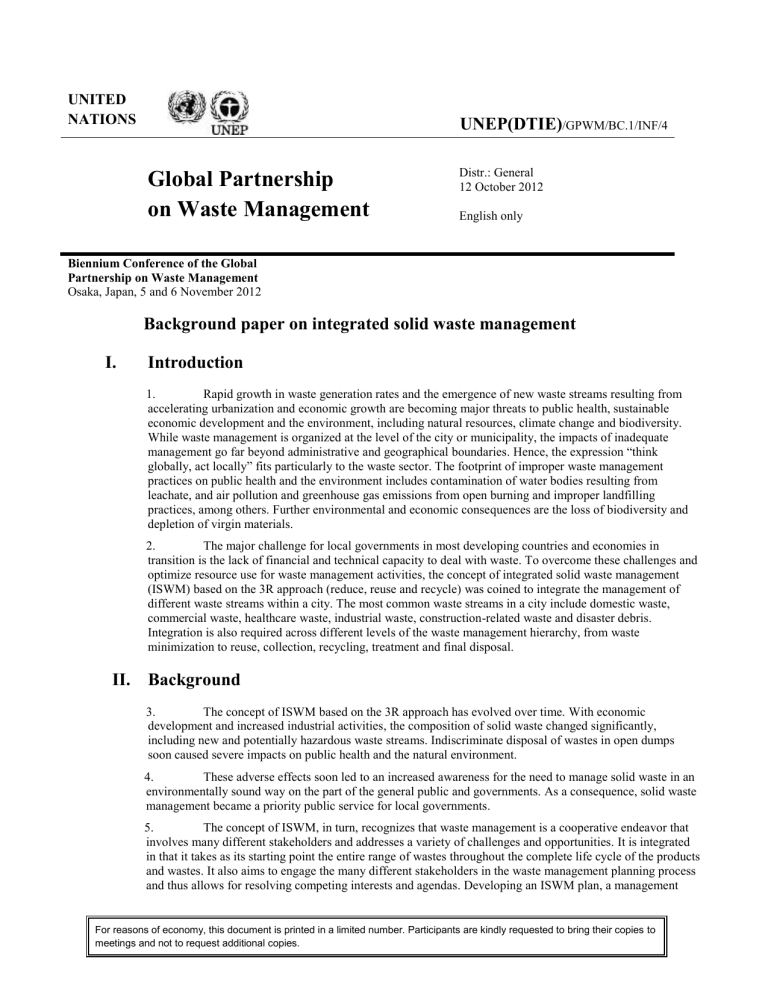
UNITED
NATIONS
UNEP(DTIE)
/GPWM/BC.1/INF/4
Global Partnership on Waste Management
Distr.: General
12 October 2012
English only
Biennium Conference of the Global
Partnership on Waste Management
Osaka, Japan, 5 and 6 November 2012
Background paper on integrated solid waste management
I.
Introduction
1.
Rapid growth in waste generation rates and the emergence of new waste streams resulting from accelerating urbanization and economic growth are becoming major threats to public health, sustainable economic development and the environment, including natural resources, climate change and biodiversity.
While waste management is organized at the level of the city or municipality, the impacts of inadequate management go far beyond administrative and geographical boundaries. Hence, the expression “think globally, act locally” fits particularly to the waste sector. The footprint of improper waste management practices on public health and the environment includes contamination of water bodies resulting from leachate, and air pollution and greenhouse gas emissions from open burning and improper landfilling practices, among others. Further environmental and economic consequences are the loss of biodiversity and depletion of virgin materials.
2.
The major challenge for local governments in most developing countries and economies in transition is the lack of financial and technical capacity to deal with waste. To overcome these challenges and optimize resource use for waste management activities, the concept of integrated solid waste management
(ISWM) based on the 3R approach (reduce, reuse and recycle) was coined to integrate the management of different waste streams within a city. The most common waste streams in a city include domestic waste, commercial waste, healthcare waste, industrial waste, construction-related waste and disaster debris.
Integration is also required across different levels of the waste management hierarchy, from waste minimization to reuse, collection, recycling, treatment and final disposal.
II.
Background
3.
The concept of ISWM based on the 3R approach has evolved over time. With economic development and increased industrial activities, the composition of solid waste changed significantly, including new and potentially hazardous waste streams. Indiscriminate disposal of wastes in open dumps soon caused severe impacts on public health and the natural environment.
4.
These adverse effects soon led to an increased awareness for the need to manage solid waste in an environmentally sound way on the part of the general public and governments. As a consequence, solid waste management became a priority public service for local governments.
5.
The concept of ISWM, in turn, recognizes that waste management is a cooperative endeavor that involves many different stakeholders and addresses a variety of challenges and opportunities. It is integrated in that it takes as its starting point the entire range of wastes throughout the complete life cycle of the products and wastes. It also aims to engage the many different stakeholders in the waste management planning process and thus allows for resolving competing interests and agendas. Developing an ISWM plan, a management
For reasons of economy, this document is printed in a limited number. Participants are kindly requested to bring their copies to meetings and not to request additional copies.
UNEP(DTIE)/GPWM/BC.1/INF/4 tool to handle waste, involves evaluating local needs and conditions, and then selecting and combining the most appropriate waste management activities for those conditions. The major ISWM activities are waste prevention, recycling and composting, and disposal in properly designed, constructed, and managed landfills.
Each of these activities requires careful planning, financing, and management.
6.
Waste management is one of the costliest public services local governments provide Collection, transportation, treatment and disposal of waste in an environmentally friendly manner become an increasingly significant financial burden with rising volumes and types of waste as local governments in developing countries and economies in transition need to import most of the modern waste collection, treatment and disposal equipment and the revenue base to support waste management is very limited. In its report “What a
Waste: A Global Review of Solid Waste Management” the World Bank has pointed out this trend, with an expected global cost of solid waste management of $375 billion in 2025 rising from about $205 billion in
2010. Cost increases will be most severe in low income countries (more than 5-fold increases) and lowermiddle income countries (more than 4-fold increases).
1
III.
Current Challenges
7.
ISWM faces a number of obstacles. One is the coordination between the different actors involved in upstream and downstream activities. While appreciating the different sectors involved in upstream waste minimization strategies (e.g. industrial and commercial), it is important to have proper coordination among the sectors on the other side of the waste spectrum that deal with downstream activities (e.g. waste management services – collection, transportation, material recovery, treatment and energy recovery and final disposal with resource recovery).
8.
Secondly, financing for waste management constitutes another obstacle. With rising waste generation rates, the emergence of new waste streams such as e-waste and increasing costs associated with waste collection, transportation, treatment and landfills, ensuring adequate financing has become ever more challenging. Conventional financial mechanisms based on subsidies, either cross subsidies or from national governments, are in most cases insufficient to cover operational costs of waste collection systems leaving no funds for treatment and disposal of collected waste. Hence, new financing mechanisms, including direct charges based on the polluter pays principle, shared responsibilities by the producers based on the concept of extended producer responsibility, and recovering resources from waste are needed. Moreover, there are various challenges including a weak policy framework and low stakeholder participation that impede better financing of the waste management sector.
9.
The third obstacle is transitioning from conventional government-led waste management services to private sector and/or community-led services. The efficiency of public sector-led services is low in many countries and the investments in services such as waste collection and transportation, material recovery, treatment and disposal are insufficient. To raise the efficiency and level of investment, increasing private sector involvement and the number of community-led initiatives for local level services are crucial.
IV.
International cooperation
10.
Following a number of high-level policy developments, in particular at the 10 th meeting of the
Conference of the Parties to the Basel Convention in Cartagena (Colombia) in October 2011, and the Rio+20 conference in June 2012, waste management is considered a high priority as this sector is key in propelling the shift to more sustainable economic development. A number of efforts by international and national stakeholders are carried out to build local and national capacity on ISWM based on the 3R approach. This includes training, demonstration projects at local level and national strategies such as a 3R strategy.
1 “What a Waste: Global Review of Solid Waste Management”, http://web.worldbank.org/WBSITE/EXTERNAL/TOPICS/EXTURBANDEVELOPMENT/0,,contentMDK:23172887~pagePK:210058~ piPK:210062~theSitePK:337178,00.html
2
UNEP(DTIE)/GPWM/BC.1/INF/4
V.
ISWM within the GPWM
11.
The GPWM explicitly addresses the concept of ISWM based on the 3R approach as one of the six focal areas. ISWM is also closely linked with all the other five focal areas. Firstly, the focal area of waste minimization is vital for promoting the holistic approach of ISWM based on the 3R approach, hence a strong coordination between the two focal areas will bring win-win situations for both areas. Secondly, the waste and climate change focal area has very close ties with ISWM as methane from landfills represents 12 percent of total global methane emissions.2. With ISWM successfully implemented, most of the waste from landfills would be diverted, thus reducing emissions. Thirdly, the work of the marine litter focal area focuses on landbased waste management systems such as ISWM for coastal cities to effectively address and reduce marine litter. Fourthly, e-waste management within cities as proposed by the e-waste focal area is closely linked to
ISWM as both focal areas involve the informal and formal recycling sector. Lastly, the focal area on waste agricultural biomass has links with ISWM as converting biomass waste into solid fuels can involve other types of wastes, e.g. plastic waste. This clearly highlights the importance and advantages of close coordination with other focal areas under the GPWM.
VI.
Possible discussion points
12.
Possible discussion points
13.
How can we raise waste management on the environmental agenda so that more resources can be allocated to this sector? How can we make the shift from conventional financing to new mechanisms based on direct charges, extended producer responsibility and earnings from waste?
14.
How can we accelerate the process of updating the policy framework to effectively cover all waste streams, new trends of converting waste into material and energy sources, and new financing and management options through private sector participation?
15.
There is a low level of administrative flexibility for international organizations, including bilateral agencies, to adjust their programme of work to quickly respond to requests from partners. How can international and bilateral agencies adapt a more flexible approach within their programmes of work to address emerging issues in the waste management sector?
16.
How can we address inadequate institutional and functional capacity for waste management in national and local governments?
17.
How can we improve the implementation of policies and regulations?
18.
How can awareness on waste management be raised effectively? How can we better take advantage of the opportunities in waste management, including the recovery of materials and the conversion to energy from waste as well as materializing the co-benefits for climate change and biodiversity?
VII.
Conclusion
19. Local and national capacity building for ISWM based on the 3R approach is vital to establish efficient and effective waste management systems with diversified benefits and co-benefits. The enormous amount of international and national efforts can make a huge difference if these are properly coordinated and synergized. The GPWM provides a forum to achieve higher level of coordination through information sharing, building networks and jointly planning acitivites.
2 Cf. Global Mitigation of Non-CO2 Greenhouse Gases (EPA Report 430-R-06-005), http://www.epa.gov/climatechange/economics/downloads/GM_SectionIII_Waste.pdf
3
